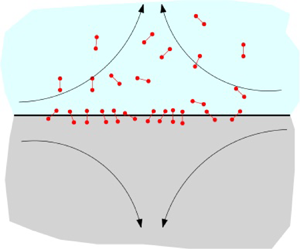No CrossRef data available.
Article contents
Fast reaction of soluble surfactant can remobilize a stagnant cap
Published online by Cambridge University Press: 11 August 2023
Abstract

Analytical solutions are derived showing that a stagnant cap of surfactant at the interface between two viscous fluids caused by a linear extensional flow can be remobilized by fast kinetic exchange of surfactant with one of the fluids. Using a complex variable formulation of this multiphysics problem at zero capillary number, zero Reynolds number and zero bulk Péclet number, and assuming a linear equation of state, it is shown that the system is governed by a forced complex Burgers equation at arbitrary surface Péclet number. Consequently, this nonlinear system is shown to be linearizable using a complex analogue of the Cole–Hopf transformation. Steady equilibria of the system at any finite value of the surface Péclet number are found explicitly in terms of parabolic cylinder functions. While surface diffusion is naturally expected to mollify sharp gradients associated with stagnant caps and to remobilize the interface, this work gives an analytical demonstration of the less intuitive result that fast kinetic exchange has a similar effect. Indeed, the analytical approach here imposes no limit on the surface Péclet number, which can be taken to be infinitely large so that surface diffusion is completely absent. Mathematically, the solution structure is then very rich allowing a theoretical investigation of this extreme case where it is seen that fast surfactant exchange with the bulk can alone remobilize a stagnant cap. Remarkably, it is also possible to track explicitly the time evolution of the system to these remobilized equilibria by finding time-evolving exact solutions.
JFM classification
- Type
- JFM Papers
- Information
- Copyright
- © The Author(s), 2023. Published by Cambridge University Press.





